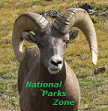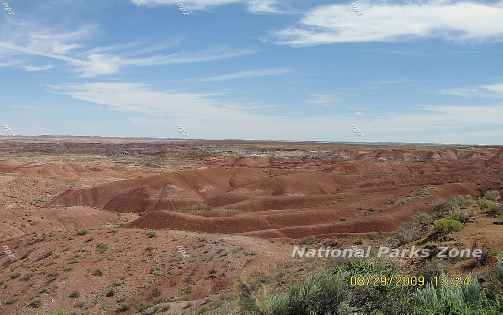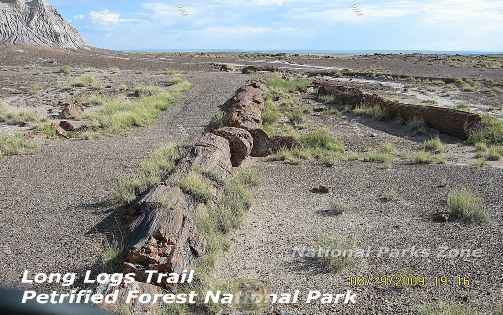Copyright © 2014-
All Rights Reserved

Updated 02/11/23 7:04 PM
Other Resources
Petrified Forest National Park on the National Parks Service website -
Petrified Forest National Park -
Petrified Forest National Park -
Petrified Forest National Park -
Petrified Forest National Park -
Petrified Forest National Park -
The Painted Desert -
Petrified Forest National Park -
Petrified Forest National Park -
Petrified Forest National Park
The Petrified Forest-
1970, 2009
About The Park
The Petrified Forest is named for the large deposits of petrified wood found there. The Painted Desert part gets its name from the highly eroded and colorful badlands of the Chinle Formation. The northern part of the park, past the visitor center, is the Painted Desert.
The Petrified Forest is also known for its fossils especially those of fallen trees that lived in the late Triassic period of the Mesozoic Era. During this epoch, what is now the park, was actually near the equator on the southwestern edge of the supercontinent called Panagea.
Most organic matter decays rapidly or is eaten by other organisms. The petrified logs found here were fallen trees that were buried quickly by sediments containing volcanic ash. The groundwater dissolved silica from the ash which was soaked into the logs and became quartz which gradually replaced the organic matter. Iron oxide and other substances combined with the silica to create the various colors found in the petrified wood. The logs retained their external form during this process, with even the bark petrifying, while the internal structure was completely replaced. All of the petrified logs in the park come from trees that are extinct.
Petrified Forest National Park was first established as a National Monument in 1906 by Teddy Roosevelt. Congress passed a bill that elevated the monument into a national park in 1962. Part of the park is designated as a wilderness area which confers on it an enhanced level of protection. This part is basically back country and accessible to those willing to venture out there.
The national park covers about 230 square miles and contains over 600 archaeological sites including many petroglyphs. There are several spots along the park road where you can see petroglyphs scratched, incised or pecked into rocks. These are estimated to be between 600 and 2,000 years old. The earliest inhabitants of the area arrived over 12,000 years ago.
This is one of the easiest parks to get to because Interstate 40 crosses it and there’s an exit for it. Formerly the historic transcontinental highway Route 66 ran through the park until it was decommissioned in favor of the Interstate. There’s an old car from the 1920’s, partly buried, as an exhibit commemorating Route 66.
The visitor center is located in what was the Painted Desert Inn and is a national historic landmark. It is a beautiful structure in the southwestern adobe style and right behind it you can stand on a patio overlooking the colorful Painted Desert.
Before the park became a National Monument, prospector’s blasted many logs with dynamite as a means of getting to the semi-
Despite this, and a guard force of seven National Park Service rangers, fences and warning signs, 12 tons (11,000 kg) of petrified wood is stolen from the park every year!
Later on this trip, I was in Canyon de Chelly National Monument which also has deposits of petrified wood in the surrounding area, there was a Navajo at one of the overlooks with a blanket with jewelry and petrified wood for sale. He had a beautiful piece about the size of a softball priced at $5. It was very colorful, had the petrified bark and I wanted it but I really didn’t want to pack a 3.5 pound rock in my suitcase for the trip home. I walked off and got about 100 feet before I went back and handed the guy the $5 and it has been on display in my house ever since. There’s a photo of it in the photo gallery along with a smaller piece that I bought in a shop in Holbrook, Arizona for about 2 or 3 dollars. There’s also a U.S. quarter coin in the picture for context and it is about the size of a piece of petrified wood that the visitor center was selling for $6! You can get the same sized piece for pocket change outside of the park.
Other Points of Interest
Kachina Point
This is behind the Painted Desert Inn and juts out into the Painted Desert. It is a great place to watch the sunset which brings out the colors of the Painted Desert.
Newpaper Rock
This area is next to the park road, in the southern part of the park, where there are over 650 petroglyphs adorning a group of rock faces.
Wildlife
Among the wildlife that call the Painted Desert home are pronghorns, bobcats, coyotes, black tailed jackrabbits, foxes and Gunnison’s prairie dogs. Pronghorns are the fastest land animals in North America and are capable of 60 mile an hour sprints and are the second fastest land animal on Earth. There’s also the usual assortment of desert snakes, lizards, reptiles, scorpions and amphibians.
More than 200 species of birds reside in the park including ravens, Golden Eagles, Anna’s hummingbirds and road runners.
Lodging
There is no longer a National Park’s Lodge in the park. Inexpensive lodging can be found in the surrounding Arizona towns of Holbrook (20 miles), Chambers (25 miles) and Windslow (50 miles).
I stayed at a Holiday Inn Express in Holbrook. When I was there in 2009 they only had internet access on one computer in the lobby area. Unfortunately I had a rental car problem and had to get online to arrange for a replacement. Waiting two hours while people read their emails was infuriating. A recent check on the web has led me to not sure if they still exist or exist as a Holiday Inn Express.
I do notice that wi-
Hiking
Keep in mind that hiking in the Petrified Forest-
Be aware of the weather at all times. Thunder and lightening are common and, being in a very exposed area, lightening is especially dangerous. Flash flooding can turn a dry wash into a dangerous torrent in an instant.
Blue Forest Trail - Blue Mesa Loop
This was a great hike through scenic, colorful badlands with petrified wood and some petrified logs jutting out of the hillsides. Part of this trail, the Blue Mesa Loop is paved. It is a manageable 3 mile round-
Long Logs Trail
This is an easy trail featuring some of the largest petrified logs in the park which is the remnant of an ancient logjam. One of them is 10 feet wide at the base. Others are quite long albeit broken into sections. The trail is a 1.6 mile loop. It can be combined with the Agate House Trail for a 2.6-
Petrified Forest National Park Photo Gallery


Other National Parks and National Monuments Within a Day’s Drive
Grand Canyon National Park -
Grand Canyon National Park -
Mesa Verde National Park Home to ancient cliff dwellings set into a beautiful mesa is 235 miles to the east and about 4 hours.
Canyonlands National Park and Arches National Park These are places of steep canyons and iconic arches and are both outside of Moab, Utah and are about 300 miles to the north and about 5 hours.
Saguaro National Park Home of the iconic Saguaro Cactus is 275 miles away and about a 5 hour drive.
Canyon de Chelly National Monument Ancient cliff dwellings carved into the sides of a steep canyon is 150 miles to the north and about 3 hours.
Monument Valley Tribal Park Famous for its massive sandstone buttes and as a backdrop for many a Hollywood western movie is 200 miles to the east and about 3.5 hours.
*N*P*Z*
National Parks Zone